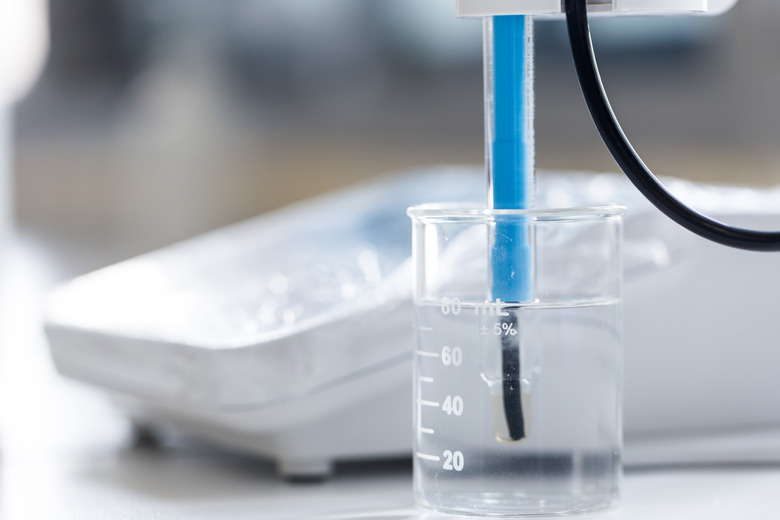How To Determine pH From pKa
You have no doubt heard of the pH scale, which is used to measure how acidic a solution (e.g., vinegar or bleach) is. You probably think of acids as being tart (for example, citric acid is a common ingredient in sour candies) and at times dangerous (most people learn to associate the word "acid" with "potential skin damage" before reaching adulthood, even if only from Hollywood movies or dire news reports).
But what is an acid, chemically speaking? And are there individual properties of different acids that make determining the pH of a solution easier, as long as you know the molar concentration of the acid dissolved in that solution? That "signature" trait is called the acid dissociation constant **Ka. ** Sometimes informally written as ka, you can calculate pH in a mathematically straightforward manner.
Acids in Solution
Acids in Solution
An acid is a molecule that can donate a proton (and rarely, more than one proton in sequence) in aqueous solution, i.e., when dissolved in water, to become ionized. This means that the proton (H+) is left to "float" among the water molecules, where it is often represented as a hydronium ion (H3O+) because of water's ability to accept these donated protons. The molecule left behind is an anion.
Example: Carbonic acid (H2CO3) donates a proton in aqueous solution to become H+ (often expressed as H3O+) and bicarbonate (HCO3−).
Strong acids such as hydrochloric acid (HCl) more "eagerly" donate protons than the far more numerous weak acids, meaning that they can offload protons even in a low-pH environment, i.e., one already rich in protons and thus not itself "eager" to take up more. Weak acids are only eager to donate their protons when the ambient pH is high, that is, the proton concentration is relatively low.
What Is the pH Scale?
What Is the pH Scale?
Above, you read that a low pH implies an environment with lots of protons freed of their parent acids. As it happens, the pH scale is a logarithmic or "log" scale that for practical purposes ranges from 1 to 14, from most to least acidic. The equation for pH is:
\(pH = -log_{10}[H^{+}]\)
Here, [H+] is the molar concentration (that is, the number of moles, or individual atoms/molecules, per liter of solution) of protons. Every tenfold increase in proton concentration drives the pH down by one integer unit and conversely.
**Example:** What is the pH of a solution of 0.025 M solution of protons?
pH = −log10[0.025 mol/L] = 1.602
The Acid Ionization Constant Ka
The Acid Ionization Constant Ka
Each acid has its own ionization constant, given by:
\(K_{a} = \dfrac{[A^{−}][H_{3}O^{+}]}{[HA]}\)
Here, [A−], [H3O+] and [HA] represent the equilibrium concentrations of ionized acid, protons and unionized (i.e., "intact") acid respectively. Ka thus offers a measure of an acid's "enthusiasm" to offload protons and thus is strength; the more strongly dissociated the acid at equilibrium, the higher the numerator in relation to the denominator in this equation and the higher the Ka.
Calculating pH from pKa: The Henderson-Hasselbach Equation
Calculating pH from pKa: The Henderson-Hasselbach Equation
You can calculate the pH of a solution given the pKa of the acid and the concentrations above, that of the donated protons excluded. Computing pKa from Ka means performing the same operation as with pH: Take the negative logarithm of Ka , and there is your answer.
The derivation is involved, but the Henderson-Hasselbach equation relates these quantities in the following manner:
\(pH = pKa + log_{10}\dfrac{[A^{-}]}{[HA]}\)
**Example:** The Ka of acetic acid, the main component of vinegar, is 1.77 × 10−5. What is the pH of a solution in which 1/10th of the acid is dissociated?
To solve, first determine pKa, which is simply −log10(1.77 × 10−5) = 4.75. Then use the fact that the ratio of [A−] to [HA} = 1/10 = 0.1
pH = 4.75 + log10 (0.1) = 4.75 + (−1) = 3.75
This means that at pH lower than acetic acid's pKa, less than half will be dissociated, or ionized; at higher pH values, more than half will be ionized. Indeed, if you set [A −] = [HA], you find that the pKa of an acid is simply the pH at which half of the acid is dissociated and half is "intact."
Cite This Article
MLA
Beck, Kevin. "How To Determine pH From pKa" sciencing.com, https://www.sciencing.com/determine-ph-pka-2832/. 23 February 2020.
APA
Beck, Kevin. (2020, February 23). How To Determine pH From pKa. sciencing.com. Retrieved from https://www.sciencing.com/determine-ph-pka-2832/
Chicago
Beck, Kevin. How To Determine pH From pKa last modified March 24, 2022. https://www.sciencing.com/determine-ph-pka-2832/
